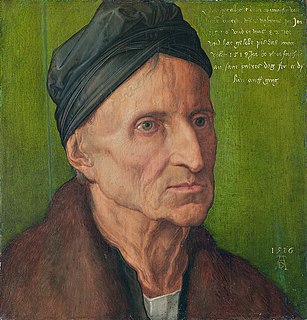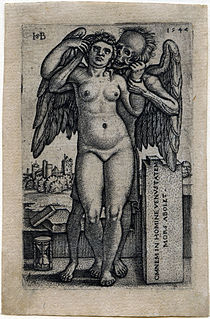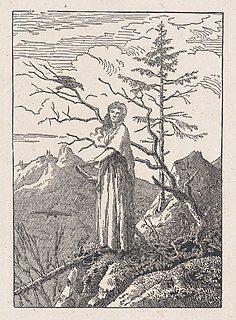Related Research Articles

Albrecht Dürer, sometimes spelled in English as Durer or Duerer, was a German painter, printmaker, and theorist of the German Renaissance. Born in Nuremberg, Dürer established his reputation and influence across Europe in his twenties due to his high-quality woodcut prints. He was in contact with the major Italian artists of his time, including Raphael, Giovanni Bellini, and Leonardo da Vinci, and from 1512 was patronized by Emperor Maximilian I.

Hans Baldung, called Hans Baldung Grien,, was an artist in painting and printmaking, engraver, draftsman, and stained glass artist, who was considered the most gifted student of Albrecht Dürer, whose art belongs to both German Renaissance and Mannerism. Throughout his lifetime, he developed a distinctive style, full of colour, expression and imagination. His talents were varied, and he produced a great and extensive variety of work including portraits, woodcuts, drawings, tapestries, altarpieces, stained glass, allegories and mythological motifs.

Woodcut is a relief printing technique in printmaking. An artist carves an image into the surface of a block of wood—typically with gouges—leaving the printing parts level with the surface while removing the non-printing parts. Areas that the artist cuts away carry no ink, while characters or images at surface level carry the ink to produce the print. The block is cut along the wood grain. The surface is covered with ink by rolling over the surface with an ink-covered roller (brayer), leaving ink upon the flat surface but not in the non-printing areas.

Martin Schongauer, also known as Martin Schön or Hübsch Martin by his contemporaries, was an Alsatian engraver and painter. He was the most important printmaker north of the Alps before Albrecht Dürer, a younger artist who collected his work. Schongauer is the first German painter to be a significant engraver, although he seems to have had the family background and training in goldsmithing which was usual for early engravers.

The Nuremberg Chronicle is an illustrated encyclopedia consisting of world historical accounts, as well as accounts told through biblical paraphrase. Subjects include human history in relation to the Bible, illustrated mythological creatures, and the histories of important Christian and secular cities from antiquity. Finished in 1493, it was originally written in Latin by Hartmann Schedel, and a German version was translated by Georg Alt. It is one of the best-documented early printed books – an incunabulum – and one of the first to successfully integrate illustrations and text.

Michael Wolgemut was a German painter and printmaker, who ran a workshop in Nuremberg. He is best known as having taught the young Albrecht Dürer.

The German Renaissance, part of the Northern Renaissance, was a cultural and artistic movement that spread among German thinkers in the 15th and 16th centuries, which developed from the Italian Renaissance. Many areas of the arts and sciences were influenced, notably by the spread of Renaissance humanism to the various German states and principalities. There were many advances made in the fields of architecture, the arts, and the sciences. Germany produced two developments that were to dominate the 16th century all over Europe: printing and the Protestant Reformation.

The Triumphal Arch is a 16th-century monumental woodcut print commissioned by the Holy Roman Emperor Maximilian I. The composite image was printed on 36 large sheets of paper from 195 separate wood blocks. At 295 × 357 centimetres (116 × 141 in), it is one of the largest prints ever produced and was intended to be pasted to walls in city halls or the palaces of princes. It is a part of a series of three huge prints created for Maximilian, the others being a Triumphal Procession which is led by a Large Triumphal Carriage ; only the Arch was completed in Maximilian's lifetime and distributed as propaganda, as he intended. Together, this series has been described by art historian Hyatt Mayor as "Maximilian's program of paper grandeur". They stand alongside two published biographical allegories in verse, the Theuerdank and Weisskunig, heavily illustrated with woodcuts.

Hans Weiditz the Younger, Hans Weiditz der Jüngere, Hans Weiditz II, was a German Renaissance artist, also known as The Petrarch Master for his woodcuts illustrating Petrarch's De remediis utriusque fortunae, or Remedies for Both Good and Bad Fortune, or Phisicke Against Fortune. He is best known today for his very lively scenes and caricatures of working life and people, many created to illustrate the abstract philosophical maxims of Cicero and Petrarch.

The Apocalypse, properly Apocalypse with Pictures, is a series of fifteen woodcuts by Albrecht Dürer published in 1498 depicting various scenes from the Book of Revelation, which rapidly brought him fame across Europe. These woodcuts likely drew on theological advice, particularly from Johannes Pirckheimer, the father of Dürer's friend Willibald Pirckheimer.

The Little Masters, were a group of German printmakers who worked in the first half of the 16th century, primarily in engraving. They specialized in very small finely detailed prints, some no larger than a postage stamp. The leading members were Hans Sebald Beham, his brother Barthel, and George Pencz, all from Nuremberg, and Heinrich Aldegrever and Albrecht Altdorfer. Many of the Little Masters' subjects were mythological or Old Testament stories, often treated erotically, or genre scenes of peasant life. The size and subject matter of the prints shows that they were designed for a market of collectors who would keep them in albums, of which a number have survived.

Jost de Negker was a cutter of woodcuts and also a printer and publisher of prints during the early 16th century, mostly in Augsburg, Germany. He was a leading "formschneider" or blockcutter of his day, but always to the design of an artist. He is "closely tied to the evolution of the fine woodcut in Northern Europe". For Adam von Bartsch, although he did not usually design or draw, the quality of his work, along with that of Hans Lützelburger and Hieronymus Andreae, was such that he should be considered as an artist. Some prints where the designer is unknown are described as by de Negker, but it is assumed there was an artist who drew the design, although it has been suggested that de Negker might fill in a landscape background to a drawing of a figure.

Johann, Johannes or Hans Wechtlin was a German Renaissance artist, active between at least 1502 and 1526, whose woodcuts are his only certainly surviving work. He was the most prolific producer of German chiaroscuro woodcuts, printed in two or more colours, during their period in fashion, though most of his output was of book illustrations.

Hieronymus Andreae, or Andreä, or Hieronymus Formschneider, was a German woodblock cutter ("formschneider"), printer, publisher and typographer closely associated with Albrecht Dürer. Andreae's best known achievements include the enormous, 192-block Triumphal Arch woodcut, designed by Dürer for Maximilian I, Holy Roman Emperor, and his design of the characteristic German "blackletter" Fraktur typeface, on which German typefaces were based for several centuries. He was also significant as a printer of music.

Leonhard Beck was a painter and designer of woodcuts in Augsburg, Germany. He was the son of Georg Beck, who was active as a miniaturist in Augsburg c. 1490-1512/15. He worked with his father on two Psalters for the Augsburg monastery in 1495. He was an assistant to Hans Holbein the Elder, working on a Holbein altarpiece now in the Städel in Frankfurt am Main in 1500-1501.

Self-Portrait is a panel painting by the German Renaissance artist Albrecht Dürer. Painted early in 1500, just before his 29th birthday, it is the last of his three painted self-portraits. Art historians consider it the most personal, iconic and complex of his self-portraits.

Portrait of the Artist Holding a Thistle is an oil painting on parchment pasted on canvas by German artist Albrecht Dürer. Painted in 1493, it is the earliest of Dürer's painted self-portraits and has been identified as one of the first self-portraits painted by a Northern artist. It was acquired in 1922 by the Louvre in Paris.

The Woman with the Spider's Web is a small 1803 print by the German Romantic painter Caspar David Friedrich, made into a woodcut the same year by his brother Christian Friedrich, a carpenter and furniture maker.

Woman with a Raven at an Abyss is a c. 1803/04 print by the German Romantic painter Caspar David Friedrich, made into a woodcut by his brother Christian Friedrich, a carpenter and furniture maker, around the same time.

The Virgin and Child With a Flower on a Grassy Bench is a drawing attributed to Albrecht Dürer. The drawing depicts Mary and child seated on a bench.
References
- 1 2 "Collections Online | British Museum". www.britishmuseum.org. Retrieved 19 July 2020.
- ↑ Giulia Bartrum. British Museum. Retrieved 31 October 2016.
- ↑ Albrecht Dürer and his Legacy. British Museum. Retrieved 31 October 2016.
- ↑ Albrecht Dürer and His Legacy: The Graphic Work of a Renaissance Artist. Princeton University Press. Retrieved 31 October 2016.
- ↑ "Edvard Munch: love and angst (British Museum)". thamesandhudson.com. Retrieved 19 July 2020.
- ↑ Bailey, Martin (19 November 2021). "Unknown Dürer drawing—bought for just $30 at a house clearance—could sell for $50m at London gallery". The Art Newspaper - International art news and events. Retrieved 29 December 2021.